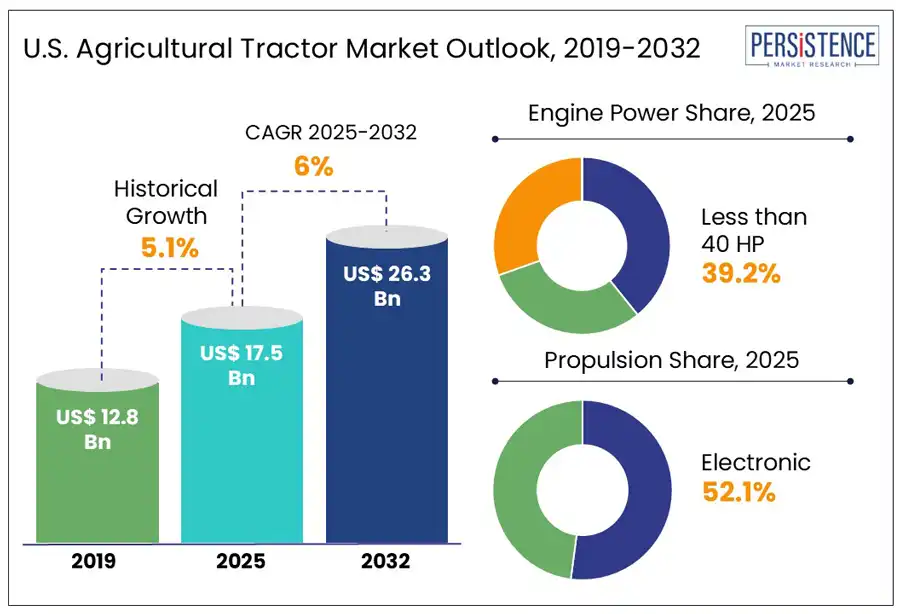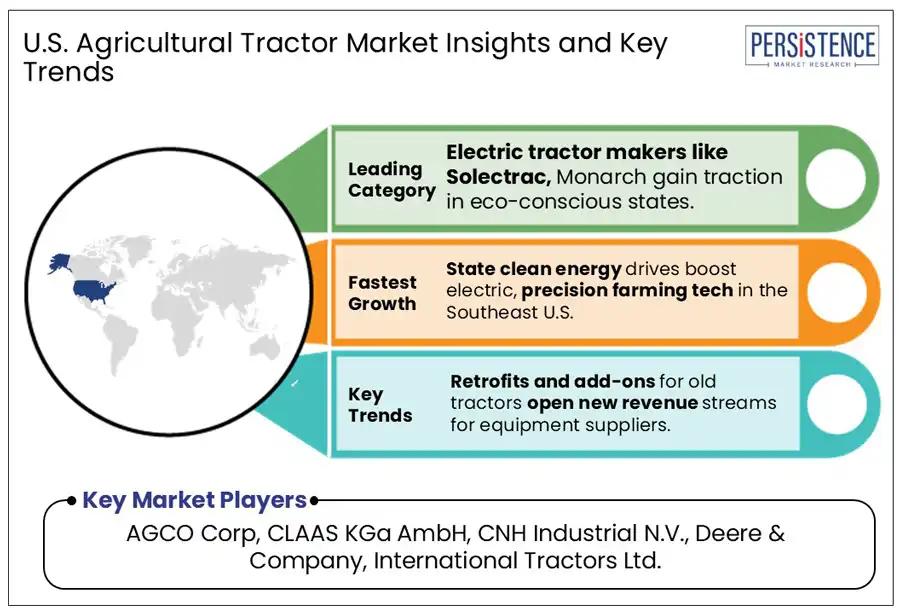Comprehensive Snapshot for U.S. Agricultural Tractor Market Including Zone and Segment Analysis in Brief.
Industry: Automotive & Transportation
Published Date: April-2025
Format: PPT*, PDF, EXCEL
Delivery Timelines: Contact Sales
Number of Pages: 200
Report ID: PMRREP35229
The U.S. agricultural tractor market size is projected to rise from US$ 17.5 Bn in 2025 to US$ 26.3 Bn to witness a CAGR of 6.0% by 2032. According to the Persistence Market Research report, this growth is powered by a convergence of factors: the dire need to maximize yields from finite farmland, a rise in labor costs, and a nationwide shift toward mechanized and precision farming. Rapid modernization of the agricultural sector creates a high demand for tractors that can be customized according to farming requirements. Technological developments such as the GPS integration, and telematics improve the technicalities. Rising computing power, emergence of big data, and innovation in machine learning algorithms are predicted to lead to tractor development that triples the productivity.

Key Industry Highlights
|
Market Attribute |
Key Insights |
|
U.S. Agricultural Tractor Market Size (2025E) |
US$ 17.5 Bn |
|
Market Value Forecast (2032F) |
US$ 26.3 Bn |
|
Projected Growth (CAGR 2025 to 2032) |
6.0% |
|
Historical Market Growth (CAGR 2019 to 2024) |
5.1% |
Constant labor shortage in the agricultural sector boosts the need for agricultural tractors. This issue has grown in the recent years due to the physically demanding nature of farm work, strict immigration policies, and demographic shifts. For example, the U.S. Department of Agriculture (USDA) stated that the current average age of a farmer in the U.S. is 58.1 years, up from 56.3 years in 2022. The aforementioned numbers highlight an aging working population with a restricted inflow of younger replacements. With the declining pool of highly skilled farm laborers, farm owners are rapidly moving toward mechanization and automation to enhance operations. Agricultural tractors are extensively used across farms in the U.S. to ensure timely insights and eliminate manual labor.
Inflation is a key factor contributing to a dip in agricultural tractor sales in the U.S., which has further surged interest rates on loan. The Federal Reserve mentioned that between 2022 and 2023, interest rates were raised several times to combat inflation. It hiked borrowing costs to high levels over two decades. Agricultural tractors are considered capital-intensive purchases that are mainly financed through loans. Hence, high interest rates have demotivated several farmers, specifically mid-sized and small-scale operations, from investing in new machinery or upgrading the existing equipment.
Increasing adoption of precision farming in the U.S. is poised to create new opportunities for agricultural tractor manufacturers. They are focusing on launching new tractors equipped with machine learning, telematics, GPS, and sensors. These enable farmers to make informed decisions about resource applications, crop planting, and soil health. The USDA Economic Research Service mentioned that farms adopting precision agriculture techniques can lower pesticide and fertilizer use by 10 to 20%, and surge crop yields by up to 15%.
Farmers are gradually inclining toward modern tractors that can help improve environmental sustainability and profitability. Case IH’s AFS Connect Magnum series, for instance, integrates precision mapping, real-time diagnostics, and cloud connectivity. Farmers can optimize field performance on-the-go, monitor inputs, and track operations from a remote device. Large-scale operations prefer this type of connectivity to avoid the misapplication of fertilizer or seeds.
Increasing demand for utility and compact tractors, specifically among small-scale farmers, landscaping businesses, and hobbyists, is estimated to be a leading market trend. The Association of Equipment Manufacturers (AEM), revealed that in 2023, tractors under 40 horsepower accounted for more than 60% of total tractor sales in the U.S. It shows a rising shift toward versatile and small farming equipment, fueled by the boom of niche farming, including greenhouse operations, vineyards, and organic agriculture. These operations require high precision and maneuverability instead of sheer horsepower. In addition, demand for easy-to-operate and affordable tractors will likely skyrocket by 2032, due to the interest of millennials and Gen Z in lifestyle or part-time farming.
Based on engine power, the market is trifurcated into less than 40 HP, 41 to 100 HP, and more than 100 HP. Among these, the less than 40 HP segment is envisioned to hold about 39.2% of the U.S. agricultural tractor market share in 2025. It is attributed to the greater convenience, compact size, and cost-effectiveness provided by tractors with an engine power of less than 40 HP.
The tractors can smoothly perform all basic farming operations. Apart from that, tractors with less than 40 HP engine power are being increasingly electrified. It is anticipated to create lucrative opportunities for manufacturers. The 41 to 100 HP segment, on the other hand, is speculated to exhibit decent growth through 2032, owing to better after-sales services and increasing awareness of new technology among farmers. These high-power tractors are gaining momentum across large farms that have more than 10 hectares.
In terms of propulsion, the market is bifurcated into electronic and ICE. The electronic segment is estimated to generate around 52.1% share in 2025. It is due to the implementation of strict emission norms at state and federal levels in the U.S. For example, the U.S. Environmental Protection Agency (EPA), has put forward stringent Tier 4 standards, mainly for diesel engines.
California pursues rigorous measures. By 2035, the California Air Resources Board (CARB) aims to phase out gas-powered off-road equipment under 25 horsepower tractor. Thus, these regulations compel the adoption of electric versions of compact tractors.
Internal Combustion Engine (ICE) propulsion is poised to showcase an average CAGR through 2032 mainly due to the rising demand from large-scale farming operations as ICE tractors. They have a high torque and operate for long hours without refueling. As of 2023, more than 90% of tractors in the U.S. still rely on diesel engines, specifically in the 100+ horsepower segment. These tractors are projected to be extensively used for heavy-duty applications such as large acreage harvesting and plowing.

West U.S. is dominated by Arizona, California, Oregon, and Washington, where farming operations range from smaller, specialty crop farms to large-scale commercial agriculture. Arizona heavily relies on irrigation for large-scale farming of crops such as melons, lettuce, and cotton due to its dry conditions. Hence, demand for premium tractors are able to handle heavy soil preparation and tilling tasks.
California’s diverse and vast farming operations will likely make it a key consumer for agricultural tractors. The state’s agricultural sector spans from small organic vegetable farms to large almond orchards. The availability of various crops and terrains requires different tractor models, such as larger ones for row crops and compact models for orchards.
Florida and Georgia are likely to spearhead the other states in terms of growth in the Southeast U.S. The region is anticipated to account for a share of nearly 26.4% in 2025. Agriculture in Florida is dominated by vegetables, sugarcane, and citrus farming. Hence, both small family-owned farms and large-scale operations seek modern tractors for smooth operations. Flat terrain and sandy soils of the state make tractors with low horsepower essential for a wide range of tasks.
Georgia is well-known for the large-scale production of pecans, cotton, and peanuts. Demand for high-powered tractors is poised to remain elevated in this state as these are capable of initiating expansive operations. The Georgia Department of Agriculture revealed that the state ranks first for peanut production in the U.S., thereby driving demand for specialized tractors for harvesting, cultivation, and planting.
The Midwest is often referred to as the ‘Corn Belt’ of the U.S. and is a significant hub for agriculture. States such as Illinois and Iowa are the leading producers of livestock, corn, wheat, and soybeans. These mainly propel demand for high-horsepower tractors for various operations. For instance, the USDA stated that more than 50% soybean and corn production of the U.S. comes from the Midwest, highlighting the significance of agricultural tractors.
Midwest has witnessed a high adoption for precision farming as tractors are embedded with variable rate technology, yield mapping, auto-steering, and GPS guidance. A 2023 survey conducted by Purdue University’s Center for Commercial Agriculture, for instance, found that nearly 69% of farmers in the Midwest utilize GPS-guided tractors. Also, about 42% have already embraced variable rate seeding technology. As these technologies lowers input costs, enhances productivity, and reduce waste.
The U.S. agricultural tractors market is highly competitive with the presence of several large- and medium-sized players. They are focusing on launching innovative tractors to cater to the varying requirements of clients. A few other companies are collaborating with start-ups to either co-develop new products or acquire their expertise. With ongoing technological developments, the market will likely see the emergence of novel digital platforms, enabling tractor users to initiate automated operations.
|
Report Attribute |
Details |
|
Historical Data/Actuals |
2019 - 2024 |
|
Forecast Period |
2025 - 2032 |
|
Market Analysis Units |
Value: US$ Bn/Mn, Volume: As Applicable |
|
Geographical Coverage |
|
|
Segmental Coverage |
|
|
Competitive Analysis |
|
|
Report Highlights |
|
|
Customization and Pricing |
Available upon request |
By Engine Power
By Driveline
By Propulsion
By Zone
To know more about delivery timeline for this report Contact Sales

The market is projected to be valued at US$ 17.5 Bn in 2025.
Increasing shortage of farm laborers and surging adoption of precision farming techniques are the key market drivers.
The U.S. agricultural tractor market is poised to witness a CAGR of 6.0% from 2025 to 2032.
The emergence of tractors embedded with yield mapping features and the rising shift of small-scale farmers toward compact tractors are the key market opportunities.
AGCO Corp., CLAAS KGa AmbH, and CNH Industrial N.V. are a few key players.